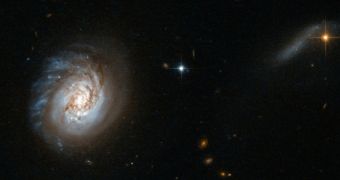The image above, collected by the NASA/ESA Hubble Space Telescope, compresses years of astronomical research in one simple view. The object dominating this field of view was dubbed MCG-03-04-014, in tune with astronomers' habit of designating all such formations with catchy names.
Objects such as this one are extremely bright in the infrared portion of the electromagnetic spectrum, but researchers are still unsure as to what powers them. Some argue that they are starburst galaxies that produce massive amounts of new stars. This hypothesis would explain the IR brightness through radiation released by young stars still cocooned in their clouds of gas and dust.
The other explanation is that monster supermassive black holes lie at the cores of these galaxies, releasing massive amounts of radiations from their accretion disks. The latter are structures through which matter is gathered and then funneled through the event horizon.
The starburst-versus-monsters debate has been raging on for quite some time now, and it is highly unlikely that this new Hubble image will clear up the mystery. What we can say for sure by looking at this image is that the shape of MCG-03-04-014 appears to be distorted by the gravitational tug of another body – most likely also a galaxy – located outside this field of view.

 14 DAY TRIAL //
14 DAY TRIAL //